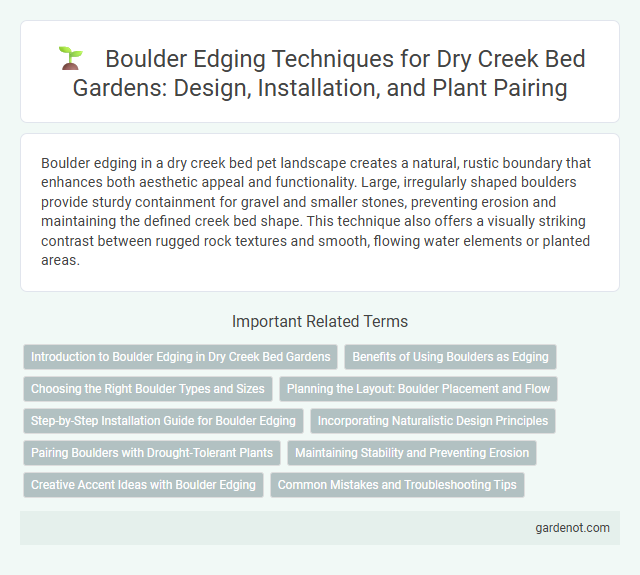Boulder edging in a dry creek bed pet landscape creates a natural, rustic boundary that enhances both aesthetic appeal and functionality. Large, irregularly shaped boulders provide sturdy containment for gravel and smaller stones, preventing erosion and maintaining the defined creek bed shape. This technique also offers a visually striking contrast between rugged rock textures and smooth, flowing water elements or planted areas.
Introduction to Boulder Edging in Dry Creek Bed Gardens
Boulder edging in dry creek bed gardens enhances natural aesthetics by creating strong, durable borders that channel water flow effectively. Utilizing large, irregularly shaped boulders provides structural stability and mimics natural streambeds, reducing soil erosion. This landscaping technique supports drought-tolerant plantings while adding texture and visual interest to outdoor spaces.
Benefits of Using Boulders as Edging
Using boulders as edging in a dry creek bed enhances natural aesthetics and durability, providing a visually striking boundary that blends seamlessly with the landscape. Boulders effectively control erosion by stabilizing soil and directing water flow, reducing maintenance needs over time. Their heavy weight ensures longevity and resistance to displacement, making them an ideal choice for long-lasting, eco-friendly edging solutions.
Choosing the Right Boulder Types and Sizes
Selecting the right boulder types and sizes is crucial for creating a functional and visually appealing dry creek bed. Opt for durable, natural stones such as granite or limestone that withstand weathering and complement the landscape's aesthetics. Incorporate varying sizes, from large focal boulders to smaller accent stones, to emulate natural water flow and enhance structural stability.
Planning the Layout: Boulder Placement and Flow
Careful planning of boulder placement in a dry creek bed enhances natural water flow and prevents erosion. Position larger boulders upstream to create flow variation, while smaller stones downstream guide water direction and sediment deposition. Strategic arrangement mimics natural streambeds, ensuring functional and aesthetically pleasing landscaping.
Step-by-Step Installation Guide for Boulder Edging
Begin by measuring the length of the dry creek bed to determine the amount of boulder edging required, ensuring each boulder is carefully selected for uniform size and shape. Excavate a shallow trench along the edge, approximately 4 to 6 inches deep, to firmly seat the boulders and prevent shifting over time. Place the boulders side by side in the trench, backfill with soil or gravel behind them, and compact to stabilize the edging for a natural, durable finish.
Incorporating Naturalistic Design Principles
Boulder edging enhances dry creek beds by integrating naturalistic design principles that mimic the organic flow of water and landscape contours. Using varied sizes and shapes of boulders creates a seamless transition between the creek bed and surrounding terrain, promoting erosion control and habitat diversity. Strategic placement of boulders supports water filtration and maintains the ecological balance within the dry creek ecosystem.
Pairing Boulders with Drought-Tolerant Plants
Pairing boulders with drought-tolerant plants enhances the natural aesthetics and functionality of a dry creek bed by creating a balanced, low-maintenance landscape. Strategic placement of large and small boulders provides structure and contrast to the textured foliage of plants like lavender, yucca, and succulents, which thrive in arid conditions. This combination improves soil stability and drainage while supporting biodiversity and reducing water use in xeriscaping designs.
Maintaining Stability and Preventing Erosion
Boulder edging in dry creek bed design enhances stability by anchoring soil and directing water flow effectively, reducing erosion risks. Properly placed boulders create natural barriers that absorb and slow runoff velocity, protecting surrounding landscapes from washouts. Incorporating varied sizes and strategic spacing ensures long-term durability and prevents displacement during heavy rain events.
Creative Accent Ideas with Boulder Edging
Boulder edging offers a durable and visually striking option for defining dry creek beds, enhancing the natural flow with rugged texture and organic shapes. Integrating varied sizes and colors of boulders creates dynamic focal points and accentuates the landscape's natural contours. Using moss or low-growing plants between boulders adds softness and contrasts, resulting in a balanced, creative outdoor feature.
Common Mistakes and Troubleshooting Tips
Improperly securing boulder edging in a dry creek bed often leads to shifting and uneven appearance, compromising both function and aesthetics. Common mistakes include using inadequate base materials that fail to provide stability and neglecting to interlock stones, which increases erosion risks during heavy rains. To troubleshoot, reinforce the base with compacted gravel and use landscape adhesive to anchor the rocks firmly, ensuring durability and maintaining the creek bed's defined contours.
Boulder edging Infographic

 gardenot.com
gardenot.com